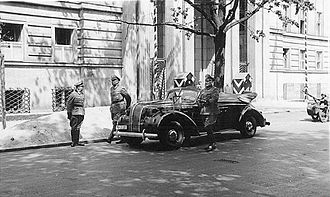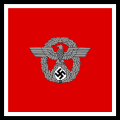Flags of the German Police (1933–1945)
The flags of the German police (1933-1945) were the flags, flags and pennants used by the regulatory police , the security police , the voluntary fire brigades and other areas under the police force during the Nazi era .
Flags up to 1933
The barracked parts of the Prussian security police (Schupo) set up as security police (Sipo) in 1919 originally did not carry any flags at all. In parades such as on the Constitutional Day, only Prussian and Reich flags were used instead of the troops' own standards. Since the aim was to strengthen the corps spirit of the police, the Prussian Minister of the Interior Carl Severing complied with a request that had been made by police officers for a long time in early 1931 and the police officer received its own flag. This was the first new troop flag that had been handed over in Germany since 1918 and was in the tradition of the old Prussian regimental flags , but was emphatically republican. It remained in use until the so-called Prussian State Police under Kurt Daluege in April 1933, in which the barracked parts of the police force were combined. This later became part of the Wehrmacht (e.g. in two regiments of the 23rd Infantry Division or in the General Göring Regiment of the Luftwaffe ).

Flags from 1933
Even after the takeover of the Nazis in 1933, the traditional countries police forces were retained initially. In January 1934, the jurisdiction of the states was transferred to the Reich. However, the full implementation did not take place until February 10, 1936, when the police were converted to the Supreme Reich Authority. In the course of this, the Reichsführer SS Heinrich Himmler was appointed head of the German police . Himmler reorganized the police again by separating them into the two sub-areas of the order police and security police.
Until the restructuring of the police authorities in 1936, the police in Germany displayed very different flags, some of which were provided with country-specific attributes. General regulations for the appearance of police flags did not yet exist. As early as the late summer of 1933, hand-embroidered flags that were based on old army flags were handed over to various state police authorities. The authorities in Prussia , Hamburg , Oldenburg , Thuringia , Württemberg and Saxony received special flags that were used there in the first few years.
- In 1933 handed over state police flags
One of the distinguishing features of the state police authorities was the independent police officer , whose origins go back to 1926. In the center of the police star was usually the coat of arms of the respective state authority. On the way to standardizing the star, the Weimar eagles (1934) and a swastika (1935–1936) were shown in the center for a time. Prussia, as the largest state police authority, already used motor vehicle flags. The Prussian police officer was put on the flag of the police chief and other subordinate officers . Trumpet or fanfare banners of the police also showed this star on a white field. In this form, the banners were still used at the Olympic Games in Berlin in 1936 . On April 1, 1933, the Prussian Police was awarded a standard that had been equipped with four police stars. The standard was similar to an SA standard , but had a narrow white border and the inscription "POLIZEI" was affixed to the name cartridge.
The police were also given the first location flags. These were modeled on the SA storm flags, but had white fringes and in the Obereck on the Liek there was a picture of a police star.
Flags from 1937
Flags, standards, fanfare banners
The complete standardization of flags and symbols of the German police took place on the occasion of the 9th party congress of the NSDAP in Nuremberg on September 10, 1937. There the first newly designed and final location flags were handed over to various police units. These corresponded in appearance to an SS storm flag with black fringes, but contained the new police eagle, which had been adopted in 1936, on a green cloth in the upper left corner. The flag mirror was piped in silver .
A special standard was made for the Berlin police on September 12, 1937. This resembled an SA standard, but in the cartridge was the new police eagle between two swastikas standing on top.
Trumpet and fanfare banners were now uniformly green with a silver-colored police emblem. The banners had silver-colored fringes on the edge.
Motor vehicle flags
Ordnungspolizei (Orpo)
As early as September 1, 1937, motor vehicle command flags were introduced for the Ordnungspolizei, which had to be attached to the left fender. The imperial and national flag measuring 20 × 30 cm was hoisted on the right fender . As an exception, the chief of the Ordnungspolizei used the Reich Service flag of the same size in their place . The rectangular stands initially had a size of 20 × 35 cm, but were changed to 20 × 30 cm on February 14, 1938. The square standard was 25 × 25 cm, while the pennants were 25 × 40 cm. As head of the German police , Heinrich Himmler carried the standard of the Reichsführer SS . The first versions had been around since 1933, the final one was introduced on December 1, 1936. The square standard had a side length of 30 cm.
The water police carried a single-colored green pennant about 20 × 30 cm in size with a police eagle on top of their service vehicles.
1 = Reichsführer SS as chief of the German police , version from 1936
2 = Chief of the Ordnungspolizei
3 = Chief of the command office and the inspectors general at the chief of the Ordnungspolizei
4 = Inspectors of the Ordnungspolizei including the commander of the Berlin Police, if they were in the general rank
5 = Inspectors the security police, including the commander of the Berlin protection police, if they were not in the general rank
6 = commanders of the protection police, the group commanders of the protection police and the commanders of the independent schools
7 = staff officers of the protection police and gendarmerie at the higher administrative authorities
8 = section commanders of the protection police and the city police of the municipal police
9 = water police pennant
Due to the effects of the war, a fire-fighting police was founded in 1941 , which expanded the circle of authorized officers of the respective command flags. Other changes were also made at this point in time:
2 = Chief of the Ordnungspolizei
3 = Chief of the command office, the general inspectors and inspectors at the Chief of the Ordnungspolizei
4 = Commander of the Ordnungspolizei, the inspectors of the Ordnungspolizei, the commander of the Berlin Protection Police and the commander of the Berlin Fire Police, if they had general rank
5 = Commander of the Ordnungspolizei, the inspectors of the Ordnungspolizei, the commander of the Berlin protection police and the commander of the Berlin fire protection police, if they did not have general rank
6 = commanders of the protection police, the group commanders of the protection police, the regimental commanders, the commanders of the police officer schools in Berlin-Köpenick and the Fürstenfeldbruck Commanders of the Technical Police School Berlin, the commanders of the Police Sports School Berlin, the commanders of the gendarmerie at the higher administrative authorities (in Baden with the state commissioners) and in the districts of the Generalgouvernement , the commanders of the fire protection police, the group commanders of the fire protection police, the commanders of the fire protection police regiments as well as the commander of the Reichsfeuerwehrschule
7 = staff officers of the protection police at the higher administrative authorities
8 = section commanders of the protection police, the battalion commanders, the commanders of all other police schools not listed under (6) the department commanders of the fire protection police and the section commanders of the fire protection police
Security Police ( SiPo ) and Security Service (SD)
In 1939 SiPo and SD were merged under the leadership of the Reich Security Main Office es (RSHA). On September 30, 1942 it was determined that separate motor vehicle command flags should be introduced for the SiPo and SD. The affixing of the flags to the vehicle complied with the regulations of the Ordnungspolizei, but the rectangular stands had a size of 20 × 35 cm. The square stands had a side length of 25 cm.
1 = Chief of the Security Police and SD
2 = Office Chiefs of the RSHA
3 = Commanders and inspectors of the SiPo and SD, the Einsatzgruppe chiefs , commanders of the driving school of the SiPo and the Security Police School in Fürstenberg , provided they had general rank
4 = Commanders and inspectors of the SiPo and of the SD, the task force chiefs, commanders of the SiPo leadership school and the security police school in Fürstenberg , if they did not have a general rank
5 = Head of the state police (head) offices and the criminal (head) offices, commanders of the SiPo and SD and commanders in the task forces
6 = SD (head) section leaders and commanders of the SD schools
Volunteer firefighter
Both the fire police , the volunteer fire brigades and the plant fire brigade were subordinate to the police. Independent motor vehicle command flags were introduced for the volunteer fire brigades on October 28, 1941. The rectangular stand had a size of 20 × 30 cm, the square stand a side length of 25 cm and the pennant dimensions of 25 × 40 cm. Showing the command flags was only allowed when the authorized person was in the vehicle, otherwise they had to be covered or removed.
1 = Head of the Office for Voluntary Fire Brigades
2 = Section inspectors of the volunteer fire brigades in Prussia, Bavaria, Saxony and in the Sudetengau
3 = District leaders of the federal states and districts who are appointed section inspectors of the volunteer fire departments
4 = District leaders of the voluntary fire departments and the civil servant directors of a state or provincial fire brigade school
5 = district leader of the volunteer fire brigades
Car flags were banned in 1945
With an order dated December 27, 1944, Heinrich Himmler prohibited the use of motor vehicle stands by the police and the entire SS:
“In the war, this regulation does not make sense, because it is precisely the task of all posts and patrols to check every car, including the one in which higher or supposedly higher commanders sit, and at the same time the duty of the higher commanders in particular to carry out these checks with the greatest self-discipline to support. In any case, the clever enemy exploits the German mentality, which has remained pretty much the same since the times of Captain von Koepenick , and camouflages his best agents with German uniforms with the highest possible insignia. With effect from 1.1.1945, I therefore forbid driving car stands for the duration of the war. "
See also
literature
- Der Flaggenkurier No. 21/22, Achim 2006, magazine of the German Society for Flag Studies, ISSN 0949-6173 .
- Davis / McGregor: Flags of the Third Reich , Part 3, London 1994, ISBN 1 85532 459 8 .
- Andreas Herzfeld: The Rimann Collection of German Car Flags and Vehicle Stands , Volume 1, Berlin 2013, ISBN 978-3-935131-08-7 .
Individual evidence
- ^ Peter Leßmann-Faust: The Prussian Police in the Weimar Republic , Verlag für Polizeiwissenschaft, 2012
- ↑ Circular of August 9, 1937, RMBliV 1937 p. 1396 ff.
- ↑ RMBliV 1938, p. 294
- ↑ SS-DV No. 25 v. September 15, 1936
- ↑ Circular of January 27, 1941, RMBliV 1941, p. 195 ff.
- ↑ BefBl Chef SichPol SD No. 45/42, p. 290 ff.
- ↑ RMBliV 1941, p. 1936 ff.
- ↑ Andreas Herzfeld: The Rimann'sche collection German car flags and car Stander , Volume 1, Berlin 2013, p 61






























